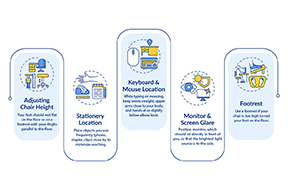

How to Improve Workplace Ergonomics
According to the U.S. Bureau of Labor Statistics, ergonomic injuries (also known as musculoskeletal disorders) make up one-third of all work-related injuries and illnesses.
The trends are concerning and costly. An estimated $1 of every $3 spent on workers compensation claims stems from ergonomic issues. Here are some related facts:
- Stress builds up in a healthy body after being in a single position for about 20 minutes.
- On average, adults spend 57% of their workday standing.
- Neck pain will be experienced by 75% of the population at some point in their lives, and about 5% won’t be able to function normally because of it.
- Doing frequent, repetitive motions of less than 30 seconds for 50% of your work time leads to higher chances of developing ergonomic injuries.
- Nearly 2 million American workers suffer from ergonomics-related or MSD injuries every year.
The goal of ergonomics is “is to prevent soft tissue injuries and musculoskeletal disorders (MSDs) caused by sudden or sustained exposure to force, vibration, repetitive motion, and awkward posture,” according to Centers for Disease Control and their National Institute for Occupational Safety and Health (NIOSH)
Basic principles of Effective and successful workplace ergonomics
Much about good ergonomic practice involves workstation arrangement, equipment orientation and employee work habits. Proper placement of workstation equipment helps, but good ergonomics starts with the selection of furniture that can be easily adjusted to meet the needs of a variety of employees.
Having an effective ergonomics process means being able to identify those job tasks and workplace factors that can put employees at risk of developing musculoskeletal disorders (MSDs). Addressing these risks can help reduce the frequency of MSDs, mitigate ergonomic risk factors and concerns, and control workers compensation costs.
According to Travelers Risk Control department, some areas to consider in minimizing the risk of MSDs include:
- Good workstation chairs.
- Proper keyboard and mouse placement.
- Correct monitor/reference material positioning.
- Sufficient lighting to help reduce eyestrain.
Good work habits are essential to avoiding injuries from computer use. Even with the best workstation and properly positioned equipment, employees could end up with discomfort or MSDs. Your employees may develop bad habits over time that can lead to the development of MSDs.
Good habits to promote include, but are not limited to:
- Change your work position, chair height and angle, and keyboard position throughout the day.
- Look away from the screen periodically to focus on distant objects.
- Use the “ALT” functions on your keyboard where possible to reduce mouse use.
- Hold the phone with your non-writing hand or use a headset. Do not hold the phone with your chin and shoulder as this can lead to neck tension, headaches and pinched nerves.
- Stand to reach items on shelves above your desk, rather than reaching from your chair.
- Squat or go to one knee while getting materials from bottom drawers or shelves.
Changing work habits takes time and dedication. Even a slight keyboard height change can initially feel awkward. If a change feels awkward, work using the modified arrangement for at least a week to give it a chance to become natural.
This Just In...Survey Finds Changes in Benefits Priorities
How to Improve Workplace Ergonomics
Employers Look to Improve Health and Benefits Offerings Ahead of 2023 Open Enrollment
The information presented and conclusions within are based upon our best judgment and analysis. It is not guaranteed information and does not necessarily reflect all available data. Web addresses are current at time of publication but subject to change. SmartsPro Marketing and The Insurance 411 do not engage in the solicitation, sale or management of securities or investments, nor does it make any recommendations on securities or investments. This material may not be quoted or reproduced in any form without publisher’s permission. All rights reserved. ©2022 The Insurance 411. Tel. 877-762-7877. www.theinsurance411.com